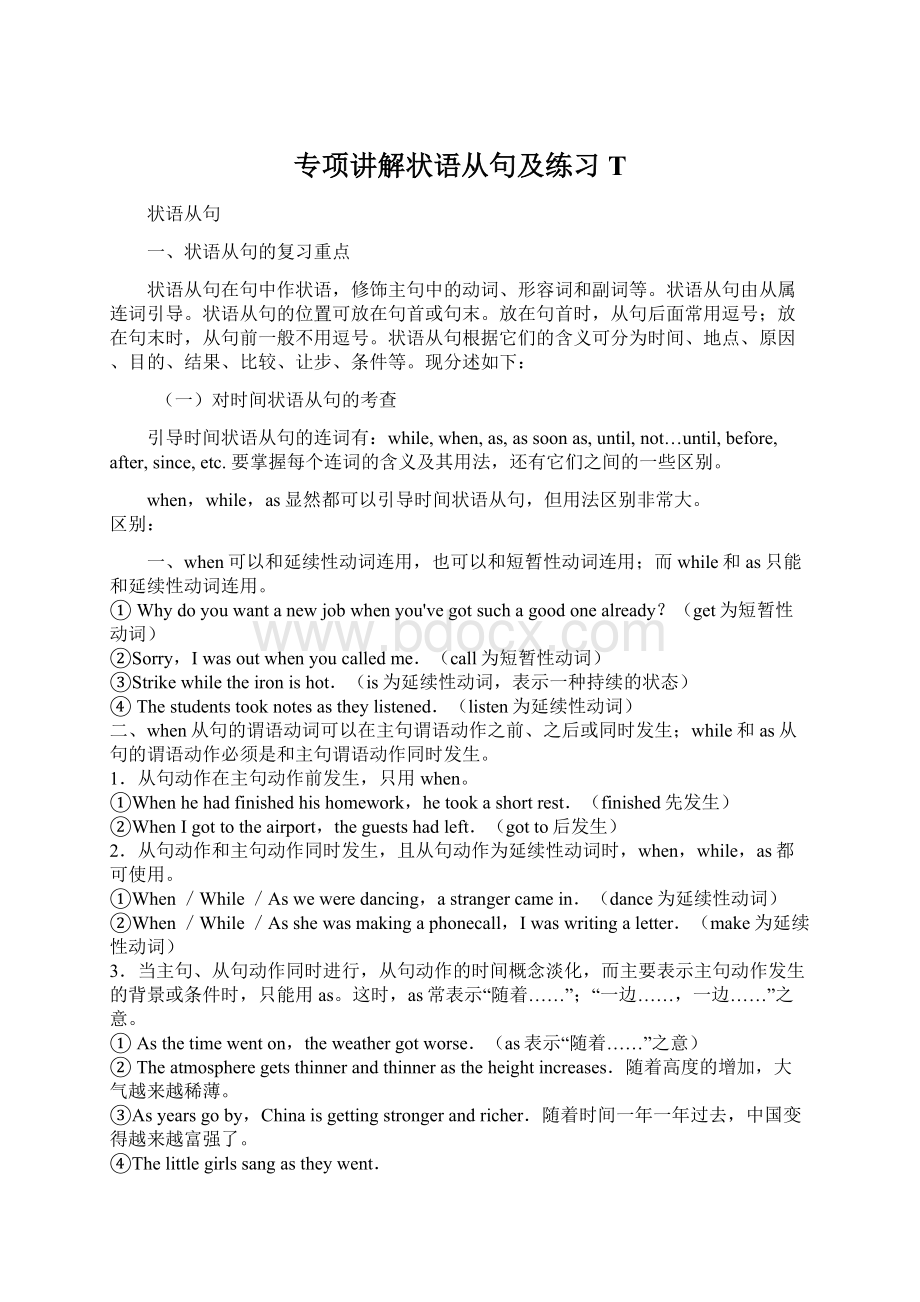专项讲解状语从句及练习TWord文件下载.docx
《专项讲解状语从句及练习TWord文件下载.docx》由会员分享,可在线阅读,更多相关《专项讲解状语从句及练习TWord文件下载.docx(19页珍藏版)》请在冰豆网上搜索。

called
me.(call为短暂性动词)
③Strike
while
the
iron
is
hot.(is为延续性动词,表示一种持续的状态)
④
The
students
took
notes
as
they
listened.(listen为延续性动词)
二、when从句的谓语动词可以在主句谓语动作之前、之后或同时发生;
while和as从句的谓语动作必须是和主句谓语动作同时发生。
1.从句动作在主句动作前发生,只用
when。
①When
he
had
finished
his
homework,he
short
rest.(finished先发生)
②When
I
to
airport,the
guests
left.(got
to后发生)
2.从句动作和主句动作同时发生,且从句动作为延续性动词时,when,while,as都可使用。
/While
/As
we
were
dancing,a
stranger
came
in.(dance为延续性动词)
she
making
phonecall,I
writing
letter.(make为延续性动词)
3.当主句、从句动作同时进行,从句动作的时间概念淡化,而主要表示主句动作发生的背景或条件时,只能用
as。
这时,as常表示“随着……”;
“一边……,一边……”之意。
As
time
went
on,the
weather
worse.(as表示“随着……”之意)
②
atmosphere
gets
thinner
and
height
increases.随着高度的增加,大气越来越稀薄。
③As
years
go
by,China
getting
stronger
richer.随着时间一年一年过去,中国变得越来越富强了。
④The
little
girls
sang
went.
⑤The
sad
mother
sat
on
roadside,shouting
crying.
4.在将来时从句中,常用when,且从句须用一般时代替将来时。
①You
shall
borrow
book
have
reading
it.
manager
comes
here
for
visit
next
week,I'
ll
talk
with
him
about
this.
归纳:
when,while,as的区别:
(1)三者均表示“当……的时候”,如果从句表示的是瞬间的动词,而主句的动作和从句动作表示的是一同时发生,三者可通用。
如:
ImetJimas/when/whileIwaswalkingalongthestreet.当我沿街散步时碰见了吉姆。
(2)as和when都可与瞬间性动词连用,while只能与延续性动词连用。
Itwassnowingwhenwegottotheairport.当我们到达机场时,天正下着雪。
(不能用while)
(3)as强调主句与从句表示的动作同时发生;
while强调主句表示的动作持续于while所指的整个时间内;
when可指主、从句所表示的动作同时或先后发生。
Hesangashewentalong.
PleasewritewhileIread.
Whenhereachedhome,hehadalittlerest.
Theteachers
_____ameeting
_____
astranger
cameinto
theoffice.
A
had,when
B
.werehaving,when
Chad,
D.werehaving,while
说明:
B错。
while引导的时间状语从句中的谓语动词一般为可延续性动词,而when引导的时间状语从句则常表示一动作正在进行,就在这时另一动作发生,因此应将while改为when.
4.till(until)(直到…….,直到……才)
until和till在肯定句中表示“直到……为止”,主句要用延续性动词;
在否定句中,表示“直到……才”,主句常用瞬间性动词,这时till和until可用before替换。
Hekeptonworkingtill(until)itwasdark.(表示主句谓语动词的动作一直延续到某一时间。
)
Hedidn’tcomebacktill(until)itwasdark.(如主句的谓语动词时瞬间动词,主句要用否定式,从句用肯定式)
Iwon’tleavetill(until)hecomesback.他回来之前我不会离开。
(从句的谓语动做是将来要发生,但时间状语从句不用将来时,须用一般时代替将来时。
5.after(在…….之后),如:
Afterhehadfinishedhishomework,hewentouttoplaybasketballwithhisclassmates.(表示从句动作发生在前,之后发生了主句的动作。
Afterhelockedthedoor,heleft.(此句虽然从句的动作发生在主句动作之前,从句的动作应该用过去完成时,但after已表示了两个动作的先后顺序,且动作连贯,无间隔。
故从句的谓语动词可用一般过去时代替过去完成时。
)
6.before(在……以前),如:
Ihadfinishedmyhomeworkbeforemymothercameback.(表示从句的动作发生在主句之后,故主句用过去完成时。
Ididn’tknowanyEnglishbeforeIcametothemiddleschool.(before引导的状语动作虽在主句动作之后,但before已表明了它们的先后,故主句也可用一般过去时代替过去完成时。
I’llfinishtheworkbeforeIleave.(此句的状语动作leave虽发生finish之后的将来,但时间状语从句不用将来时,须用一般现在时来代替一般将来时。
7.since(自……以来)如:
从句的谓语动词表示主句的动作起点,从句用一般过去时。
主句的谓语动词表示动作开始以后一直延续至今,一般用现在完成时。
Hehasstudiedatthisschoolsincehisfamilycametothiscity.
Itis/hasbeen….since句式如主句的动词表示的不是延续动作,而是目前情况或状态,主句用一般现在时,从句仍用一般过去时。
Itisthreeyearssincehecamehere.
8.assoonas(一……就),表示主句、从句的动作紧密相连,主句、从句都可用一般过去时。
ThetrainstartedassoonasIgotonit.
I’llwritetoyouassoonasIgetthere.(此句从句的动作发生在将来,但assoonas引导的时间状语从句不用将来时,要用一般现在时代替一般将来时;
用一般过去时代替过去将来时。
I’ll____
theletter
tohim
assoonas
he______.
give,willcome
back
B.wilgive,willcome
C.give,comes
Dwillgive,comesback
D。
assoonas引导的是时间状语从句,在时间状语从句中不用将来时,应用一般现在时代替一般将来时,因此D部分应该为comesback.
(二)对条件状语从句的考查
要点:
引导条件状语从句的连词有if(如果)、unless(除非)等,unless在意义上相当于if…not。
条件状语从句也像时间状语从句一样。
We’llhaveoursportsmeetunlessitrainstomorrow.(=We’llhaveoursportsmeetifitdoesn’train.)
Youwillfailunlessyoustudyhard.(=Youwillfailifyoudon'
tstudyhard.)
如果主句是一般将来时,从句须用一般现在时(主将从现);
IfIgetupat9:
00,Iwillbelate.
IfIamlate,theteacherwillbeangrywithme.
Iftheteacherisangrywithme,Iwillbesad.
主句是过去将来时,从句用一般过去时。
Hesaidhewouldgotoherbirthdaypartyifsheinvitedhim.
主句有must,canmay等情态动词时,从句用一般现在时。
(主情从现在)
Youmuststopifthetrafficelightisred.
主句是祈使句,从句用一般现在时。
(主祈从现)
Putupyourhandsifyouhaveanyquestions.
练习:
I____(will)gowithyouifI___(be)free.(will,am)
Ifyou_____(work)hard,you_____(make)greatprogress.(work,willmake)
Hesaidhewould(will)gotoherbirthdaypartyifshe___(invite)him.(invited)
Don’twaitformeifI____(be)late.(am)
Ifhe____(want)togetgoodmarks,hemust___(study)hard.(wants,study)
(三)对比较状语从句的考查
引导比较状语从句的连词有as…as,than,notso(as)…as等构成。
涉及数量的用asmany+可数名词复数+as”或“asmuch+不可数名词+as”结构,涉及倍数的用“…timesas…as”结构。
在使用这些句型中要特别留心引导词的正确使用,以及与它有关联的词的对应关系。
1.由than引导的比较状语从句是由“形容词或副词的比较级+than+省去与前句相同部分的省略句”构成。
Heistallerthananyotherstudentinhisclass.
Theirclassroomismuchlargerthanours.
Hestudiesevenharderthanhisbrother.
注:
单音节形容词或副词的比较级前可加much,still,far,even,alot,alittle,agreatdeal,any等修饰词,加强语气或说明程度。
2.由“as+形容词或副词原级+as”构成的比较状语从句用来表示两事物在某方面一样或不一样。
它的否定式为“notso(as)…as”。
Ourclassroomisasbigastheirs./Ourhouseisnotso(as)bigastheirs.
HespeaksEnglishaswellashisteacher./Hedoesn’tstudyashardashisbrother.
注意防止对此结构的误用。
A.
她不比她妹妹舞跳得好。
误①:
Shedoesn’tdanceasbetterashersister.②:
Shedoesn’tdanceasbestashersister.
误③:
Shedoesn’tdanceasgoodashersister.
正①:
Shedoesn’tdanceaswellashersister.②:
Shedoesn’tdancesowellashersister.
“as…as”“so…as”结构中的形容词或副词只能用原级,不能用比较或最高级,如误①,误②。
使用此结构还要注意避免形容词或副词的误用。
如误③中的形容词,不能修饰谓语动词dance,应改用副词well,如正①,正②。
B.他和他弟弟一样学习努力。
误:
Hestudiessohardashisbrother.
正:
Hestudiesashardashisbrother.
“as…as”结构既可用于肯定句,也可用于否定句。
但“so…as”结构只能用于否定句。
3.“asmany+可数名词复数+as”和“asmuch+不可数名词+as”结构。
Hehasasmanysweetsashisbrother.他的糖果和他弟弟的一样多。
Hehasasmuchmoneyashissister.他的钱和他妹妹的一样多。
Hehasn’tgotasmanypicturebooksashislittlebrother.他的小画书没有他小弟弟的多。
Hedidn’teatasmuchashisbrother.他没有他弟弟吃得多。
4.用“twice或three(four…)times+asmany(+可数名词复数)”或“much(+不可数名词)+as”结构表示倍数关系。
HehastwiceasmanyEnglishdictionariesasI.他的英语字典的数量是我的两倍。
Hismoneyisfivetimesasmuchasmine.他的钱是我的钱的五倍。
[例题1]Hestudiesharderthan______inhisclass.
A.allthestudents
B.anystudent
C.anyotherstudent
D.allothers
在A项和B项中都包括“他”本人在内,这就可能造成他比他自己学习更努力,逻辑上有错误。
因此可排除A项和B项;
D项中others应特指他们班上的其他同学,应加定冠词,故答案为C.
[例题2]单项选择
Hehastwice______hiselderbrother.
A.somanybooksas
B.asmuchbooksas
C.asmanybooksas
D.somuchbooksas
somuch和asmuch只能修饰不可数名词,因此可先排除B项和D项;
又因为so…as只能用于否定句而不能用于肯定句,所以应排除A项而选C项。
中考链接
--Canyouguesswhowillbethefirsttocrossthefinishline?
(2005南通)
--Sandy.Janedidn’trunsofast______shedidlasttime.
A.than
B.so
C.that
D.as
[研析]D.“(not)so/as+原级+as”表示“……(不及)和……一样”的意思,as后接比较对象。
Mikesings_________hiselderbrother.
A.AsgoodasB.aswellasC.sogoodasD.sowellas
答案:
B
(四)结果状语从句
引导结果状语从句的连词有so…that(如此……以致于),such…that(如此……以致于)等。
常用句型:
So….that….的用法:
so+
Adj/adv
Many/few+复数可数名词+that从句
Much/little+不可数名词
Adj+a/an+单数可数名词
(1)so+形容词/副词+that从句
Hisshoesweresodirtythathemustbrushthem.
Thesuitcostsomuchthathedidn’tbuyit.
HespokesofastthatIcouldn'
tfollowhim.
(2)so+形容词+a/an+单数可数名词+that从句
Tomissocleveraboythathecananswerthequestion.
(3)so+many/few+复数可数名词+that从句
ThereweresomanypeopleinthebusthatIcouldn’tgeton.
(4)so+much/little+不可数名词+that从句
Hehassomuchworktodothathecan’tcomethisevening.
(5)sucha/an+形容词+单数可数名词+that从句
Itissuchaheavyboxthatnobodycanmoveit.
It’ssuchaninterestingstorythateverybodylikesreadingit.
(6)such+形容词+复数可数名词/不可数名词+that从句
Hetoldussuchfunnystoriesthatwealllaughed.
Itissuchbadweatherthatwehavetostayathome.。
[典例探究]
例1–Jack,youlooktiredtoday.What’swrong?
(2005吉林)
--Iwas______busy______Ididn’tgotobeduntilmidnightyesterday.
A.too,to
B.enough,to
C.so,that
D.such,that
[研析]C。
此题考查so…that引导结果状语从句的用法。
so后接形容词或副词;
such…that也引导结果状语从句,不过such后须接名词。
例2
Sorry,youspeak______quickly______Ican’tfollowyou.(2004长春)
B.so,that
C.as,to
D.very,so
[研析]B.so…that…意为“如此……以至……”,引导结果状语从句。
意思是“你说得这样快,我听不清楚你的话。
”
例3:
Hehas____littletimethathecan’tgotothecinemawithyou.
A.SoB.suchC.MuchDmanyKey:
A.
(五)目的状语从句
sothat/inorderthat(以便),常和情态动词连用may/minght.can/could,will/would。
Sothat只能放在句中。
Ipackedhimalittlefoodsothathewouldn'
tbehungry.
WestoppedatHangzhousothatwemightgototheWestLake.
sothat引导的目的状语从句可转换成动词不定式短语。
例如:
Shehurriedtoschoolsothatshemightnotbelate.
→Shehurriedtoschool(inorder)nottobelate.。
[典例探究]
Sheboughtadigitalcameraonline______shesavedalotoftime.(2003扬州)
A.sothat
B.assoonas
C.nomatter
D.suchthat
[研析]A。
sothat作“为了”“以便”解,引导目的状语从句,句意是“为了节约时间,她在网上买了一台数码相机。
(六)对其它状语从句的考查
还有五种状语从句:
地点状语从句、原因状语从句、目的状语从句、方式状语从句、让步状语从句。
掌握常用的引导词:
1)引导地点状语从句的有:
where(在哪里),wherever(无论何地),etc.如:
Wherethereisawill,thereisaway.
Whereveryougo,Igotoo.
2)引导原因状语从句的有because,as,since(因为)。
because常回答why引导的疑问句,该从句一般位于主句后;
since比as正式,两者不回答why引导的问句,而且其从句一般放在句首。
Whycan'
tIgo?
Becauseyou'
retooyoung.
As(Since)youarenotfeelingwell,you'
dbetterstayathome.
注意:
because不能和so用在同一个句子中。
出现任意一个都是“因为…,所以…”含义。
如下列两句,句意